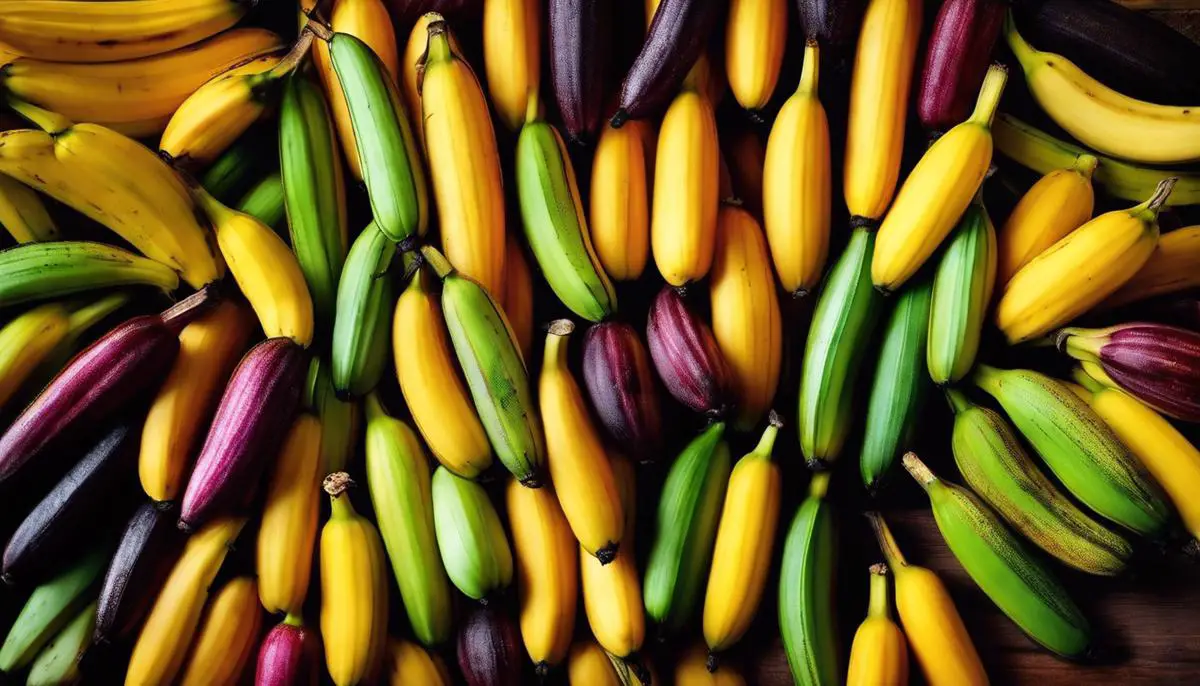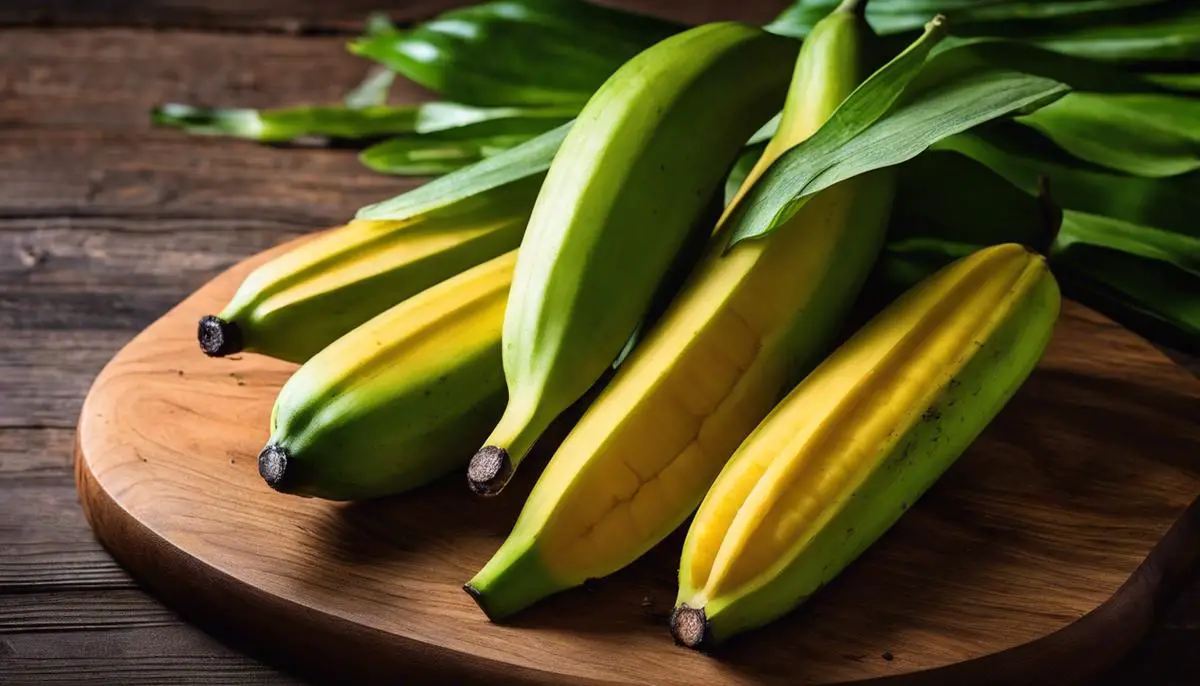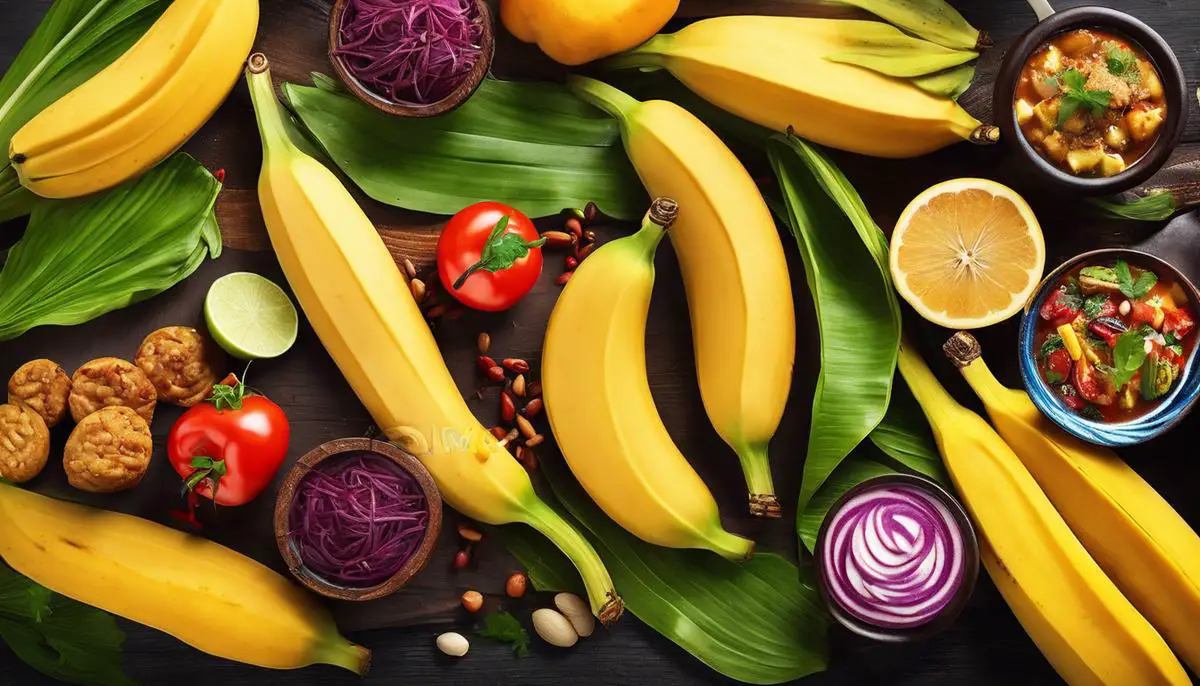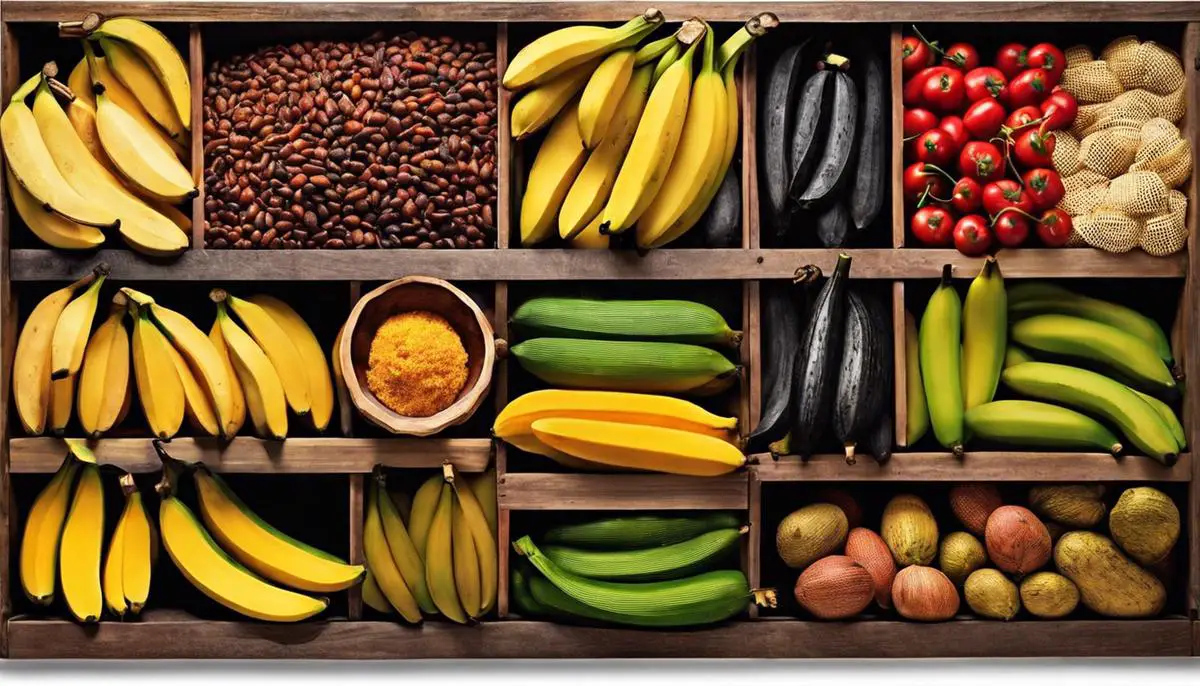
At first glance, you might mistake a plantain for a common banana. However, plantains are far more than oversized variants of their familiar, sweet counterparts. These tropical treasures are not only larger and starchier but also boast a cornucopia of culinary uses, making them staples in diverse global cuisines. From the deep jungles of Africa to the bustling streets of Latin America and the vibrant islands of the Caribbean, plantains showcase true gastronomic versatility. This exploration into plantains will reveal their distinct characteristics, discuss the myriad ways they can transform meals, and provide fascinating insights into their preparation and cooking techniques.
Understanding Plantains
The Unsung Culinary Delight: Plantains!
Hidden in the vibrant chaos of world cuisine, there is one delicacy that has long secured a place in global gastronomy: the humble plantain. Aesthetically similar to the banana, plantains carry a unique charm, distinct flavor, and versatility that truly sets them apart in the culinary world. Exotic, eccentric, yet abundantly available, they are like the secret ingredient in a master chef’s recipe book that never fails to impress.
What sets plantains apart? It’s their incredible versatility. Unlike their sweeter relatives, the bananas, plantains are starchier. They can be enjoyed at different stages of their lifecycle, each offering a unique flavor profile. When green, they impart an earthy, potato-like flavor, ideal for savory dishes. As they ripen, they inherit a caramel sweetness, making them perfect for desserts without becoming overpoweringly saccharine.
Regardless of their stage, plantains have an impressive culinary range. Their starchy, resilient texture lends beautifully to multiple cooking methods. They can be grilled, baked, boiled, or perhaps most famously, fried into tostones or plantain chips – each method unlocking delightful tastes and textures.
One doesn’t merely eat plantains. They present an exciting adventure and experimenting with them is like entering a delicious playground. For instance, in Caribbean cuisine, ripe plantains are often baked with spices and served as a sweet-savory side dish, effortlessly complementing the main course. In African kitchens, they’re mashed into mofongo, a classic dish hailing from Puerto Rico. Latin American chefs have transformed green plantains into chifles, thin, crispy snacks akin to potato chips, and the delightfully fluffy empanadas. The diverse range of dishes plantains can be incorporated into is astonishing and a testament to their culinary endurance.
Nutritionally, plantains are no lightweight either. They’re rich in vitamins, particularly A and C, and a great source of fiber and minerals such as potassium and magnesium. With low-fat content, this hardworking ingredient not only promises indulgence but smart nutrition too.
Among myriad ingredients available in a chef’s arsenal, discovering plantains can be a refreshing experience. This seemingly ordinary produce holds within it extraordinary flavors and an overwhelming potential for culinary innovation. So, for all who enjoy widening their culinary horizons, the plantain is ready for its time to shine on your plates. Go ahead, snag one from the local market, experiment in the kitchen, and sit back as the flavor launching transforms your meals into something extraordinary. Allow the humble plantain to inspire a culinary journey that is anything but ordinary. Indeed, the joy of food lies in its diversity and plantains are a perfect testament to that.

Versatility of Plantain Recipes
There is no doubt that plantains bring a wealth of taste and nutrition to the table, but their influence extends far beyond that. They open our eyes to a broad array of diverse delight, imparting a wealth of culinary value to global cuisine. Let’s take a moment to explore just how central plantains are in a host of different food cultures worldwide.
Plantains are an integral part of Caribbean food culture, where they are almost as ubiquitous as rice. The islanders adore and view this ingredient as an all-rounder. Apart from the classic plata maduro, or sweet fried plantains, the Caribbean cuisine also utilizes plantains in a dish named ‘escovitch’, where vinegar-soaked veggies are served over fried fish and boiled plantains. It’s a dish that makes your taste buds do a mini reggae dance with every bite.
Travel a little more to the east and you land in Africa, another continent where plantains play a star role. The beloved ‘Aloco or Alloco’, a popular dish from Côte d’Ivoire, is a delicious example of plantains in African cuisine. This is a simple dish of ripe plantains fried in palm oil until golden and caramelized, often served with grilled fish and a spicy tomato-onion sauce. It’s comfort food, perfected by the generations.
Now, let’s take a flight all the way to the East- Asia. Although not as prevalent, plantains have made their unique impressions here too. In Kerala, a southern state of India known for its tropical cuisine, a side dish called ‘Ethakka Upperi’ is served, which is essentially deep-fried plantain chips. This crispy delicacy, often served in traditional meals, leaves a lingering sweetness in your mouth that no store-bought potato chips can compete with.
Sail across the sea and you’ll find that plantains hold their own in South America as well. In Brazil, ‘farofa’, a toasted cassava flour mixture, often includes bacon, plantains, and plenty of spices. It’s more of an accompaniment but trust this, a bite of farofa with a piece of meat or fish, and you’ll be singing samba in no time.
Let’s not forget North America, where plantains enjoy a devoted following in several regional cuisines, notably in Southern States influenced by Creole and Cajun cooking. The beloved Jibarito sandwich, an iconic Puerto Rican invention that uses crispy fried green plantains instead of bread, remains a favorite in many Chicago eateries.
No matter the cuisine, plantains add an irresistible combination of sweet, savory, creamy and crunchy to every bite, allowing them to play center stage or supportive roles, as befits the dish. What’s more, they often offer an affordable and sustainable means of introducing rich, complex flavor into dishes.
The use of plantains in global cuisine demonstrates their universal appeal and showcases their versatility in numerous culinary applications. So the next time you spot this delightful gem in the grocery store, grab a bunch, and dive into the endless possibilities that plantains hold in your kitchen! The world, indeed, is a tastier place, thanks to plantains.

Cooking Techniques for Plantains
To venture further into the world of plantains and their diverse culinary renditions, it’s essential to recognize the impact of various cooking techniques applied to this food wonder. Surely, everything we’ve touched upon so far only amplifies our appreciation for this extraordinary ingredient.
So, stepping into the specific realm of cooking techniques and how they enhance flavor, let’s dive deeper. Smash and fry; a technique mostly used for tostones or patacones (twice-fried plantain slices). First, the exterior of the plantain is crisped up in hot oil, then, after a brief cooling period, they are smashed to expose more surface area, then returned to the cooking pot for a second fry. This process intensifies the natural sugars in the plantains, creating a delightful balance of crispness and soft interior.
Steaming, often overlooked, is a gem of a technique where plantains are concerned. It preserves not only the nutritional edge of the plantain but also its delicate flavor. The steam’s gentle heat cooks the plantains just enough to allow their natural flavors and sugars to bloom without any browning or caramelization.
A roasting technique can be an ideal match for plantains, particularly when they’re paired with equally robust ingredients. Roasting brings out their bold, natural sweetness and imparts a rich, caramelized tone to their flavor profile.
Lastly, one cannot ignore the joys of sautéing or pan-frying plantains. This technique allows for a delightful, golden-browned exterior while preserving the plantain’s inherently creamy interior. A sprinkle of spice, a dash of heat, or even a splash of citrus can dramatically enhance the dish during this process.
Indeed, the beauty of plantains isn’t confined to their innate flavor profiles or the nutritional bounty they offer; rather, it extends to their uncanny ability to absorb the essence of whatever they are cooked with. From the punchy heat of a jalapeno to the humble sweet tones of cinnamon, plantains are game for anything!
Tying this all together is the crucial theme of timing. Knowing when to utilize a particular cooking method with respect to the plantain’s ripeness is key in bringing out its rich potential. A deep understanding of these techniques not only gives the cook a versatile toolbox but also a refined appreciation for the intricate dance of flavors that plantains bring to the culinary world.
As a staple in various world cuisines, such as the Caribbean, African, East-Asian, South American, and North American cuisines, among others, plantains confidently defies any geographical boundaries. They joyfully find their place both in a humble home kitchen and an upscale restaurant, offering diverse elements of sweet, savory, creamy, and crunchy in any dish. This universal appeal, versatility, and affordability of plantains are a loud echo of the common love for food that binds us all in global gastronomic harmony.
Let plantains remind us that even the simplest ingredients can open doors to a host of flavor possibilities begging to be explored. Expand your culinary repertoire and experience the thrill of creating (and partaking!) in dishes bursting with essence of all kinds: sweet, savory, spicy, and everything in between. Like most of life’s finest moments, the joy, after all, is in the journey!

Delectable Plantain-based Dishes
Delving further into the culinary secrets of plantains, it’s worth noting their chameleonic nature. Plantains seamlessly adopt the characteristics of whatever culinary treatment we choose to confer upon them. From the smash and fry technique, a beloved Caribbean practice where ripe plantains are mashed and then deep-fried to create the golden brown, thumb-imprint laden tostones; to steaming them gently, releasing their sweet flavor slowly yet intensely; from roasting them patiently to unlock a robust, concentrated taste; to sautéing or pan-frying them for a crispy, caramelized edge while maintaining a delicately soft center.
What gives these cooking methods their charm is how they allow the plantains to absorb flavors while perfectly hosting robust ingredients. Imagine bathed in a savory soup or blanket-wrapped in a spiced dough, plantains bring out an aromatic symphony in every bite. They serve as the perfect canvas for spices, heat, or citrus, and always deliver a flavor launching.
The ‘when’ and ‘how ripe’ are often the two key mysteries that surround cooking with plantains. Remember, timing is everything. The right level of ripeness determines the method of cooking; green plantains are excellent for chips or tostones, while ripe ones create sweet, caramelized wonders. Their ripeness can elevate the flavors and bring a texture that complements the entire dish.
Every gastronomic culture around the globe has found a space for plantains in their recipe books. Their universal appeal resonates from roadside eateries in the Caribbean to African home kitchens, from vibrant South American local markets to upscale North American gourmet restaurants, and from bustling Indian streets to serene East-Asian gardens. The universal appeal and versatility of plantains truly underscore their essential role in world cuisines.
This journey invites us to respect and appreciate seemingly simple ingredients like plantains. They’re more than just a fruit; they’re a treasure trove of diverse flavor possibilities. The art of transforming such simple ingredients into culinary masterpieces is a rewarding feat that expands our gastronomic repertoire, stimulating our taste buds and firing our imagination.
Every spoonful of plantain brings with it a whisper of tropical sunsets, swaying palm trees, and the rhythm of life itself, a symphony that quenches the soul as much as the palate. It’s a romantic testament to global gastronomic harmony, a reminder that something as basic as a vibrantly yellow fruit can unite people across cultures in a shared love for food. In the end, aren’t we all just fellow diners on this expanse of the spinning globe, speaking the universal language of good food? Indeed, plantains symbolize the very essence of this belief.

As our culinarial journey reaches its end, it becomes evident that plantains are true culinary gems. Their flexibility in the kitchen is mirrored in the rich tapestry of dishes they help construct, underscoring their importance within world cuisine. Whether used to prepare snacks, main courses, or dessert, plantains infuse dishes with unique textures and flavors that become the signature of many traditional and contemporary dishes worldwide. So, embrace this vibrant fruit, equip yourself with the right techniques, and let your culinary creativity soar to new heights, proving the power of plantains to transform your meals into delectable masterpieces.



